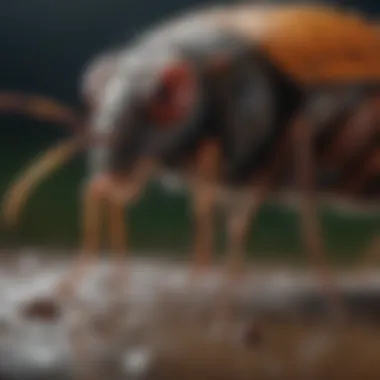FL Pest Control in Crystal River: Strategies and Insights


Intro
Pest control is an essential aspect of maintaining a healthy living environment, particularly in areas like Crystal River, Florida. Navigating the complexities of pest management requires understanding not only the pests themselves but also effective strategies and solutions tailored to the local ecosystem. This article aims to provide homeowners and housewives with insightful information about common pest issues in the region, prevention techniques, and eco-friendly approaches that can be embraced to ensure a sustainable environment.
By understanding local biodiversity and its influence on pest behavior, readers will find practical advice that empowers them to tackle pest problems effectively, without compromising their health or the health of their surroundings.
Understanding Pests
Definition of Pests
Pests are organisms that can interfere with human activities. They may damage property, spread disease, or disrupt the environment. Common pests identified in Crystal River include insects such as ants, termites, and mosquitoes, as well as rodents like mice and rats. Each category of pest presents its own particular challenges, which necessitates tailored management strategies.
Importance of Pest Identification
Identifying pests accurately is crucial. Not all insects or organisms are harmful. Understanding whether a creature is a pest or a beneficial species can change how one approaches its management. For instance, ladybugs are beneficial by controlling aphid populations in gardens, while fire ants can threaten both gardens and health. Better identification empowers homeowners to apply the most effective control measures, preventing unnecessary harm to non-target species or the environment.
Prevention Techniques
Home and Garden Preventative Measures
Preventative measures play a vital role in pest control. Homeowners should consider several steps to deter pests:
- Seal entry points: Check windows, doors, and foundation for gaps and cracks.
- Reduce clutter: Keep basements and attics organized to minimize hiding places for pests.
- Maintain cleanliness: Regularly clean kitchens and dining areas to remove food debris that attracts pests.
- Proper waste management: Use tightly sealed containers for trash and remove waste frequently.
In gardens, specific actions can be taken:
- Plant selection: Choose native plants that thrive in the local environment, as they can be more resilient to pests.
- Companion planting: Use plants that repel pests to naturally reduce infestations.
Seasonal Prevention Tips
Understanding seasonal variations can enhance pest prevention strategies:
- Spring: Inspect for termite damage and seal cracks in foundations.
- Summer: Monitor for mosquito breeding in stagnant water.
- Fall: Clean out gutters to prevent accumulation and reduce spider habitats.
- Winter: Ensure attics and basements are well insulated to keep rodents from seeking shelter indoors.
Eco-Friendly Pest Control Solutions
Overview of Sustainable Practices
Adopting eco-friendly pest control methods can benefit the environment while effectively managing pest populations. Integrated Pest Management, or IPM, is a holistic approach that combines several strategies:
- Monitoring: Regularly check for pest activity to identify problems early.
- Thresholds: Establish acceptable levels of pest activity to reduce unnecessary treatments.
- Biological control: Introduce natural predators to manage pest populations.
Natural Remedies and Their Effectiveness
Homeowners can utilize several natural remedies to combat pest issues:
- Diatomaceous earth: This natural powder disrupts the exoskeletons of insects, causing dehydration.
- Essential oils: Oils like peppermint or tea tree can repel various pests effectively.
- Vinegar: A mixture of vinegar and water can deter ants and other insects.
While natural remedies offer benefits, they must be applied with caution, particularly in households with pets or allergies.
Invest in understanding local pests and methods to create a balanced ecosystem while managing them effectively.
To navigate the challenges of pest control in Crystal River, adopting a comprehensive understanding is crucial. The integration of prevention techniques and eco-friendly solutions offers a well-rounded approach that can lead to successful pest management. By embracing these practices, homeowners not only protect their properties but also contribute positively to the local environment.
Preamble to Pest Control in Crystal River
Pest control in Crystal River, Florida, is a multifaceted issue that requires an understanding of various factors. This area provides a unique habitat that supports diverse wildlife and plant species. Therefore, managing pests effectively is not just about eliminating unwanted guests; it is about maintaining a balance within the ecosystem. Proper pest control strategies can protect homes, gardens, and the local environment.
In Crystal River, homeowners face specific pest challenges that are intrinsic to the region's climate and geography. Addressing these challenges through thoughtful, informed pest control practices not only enhances property value but also promotes ecological harmony. As we explore this subject, it becomes clear that effective pest management is crucial for sustaining community health and quality of life.
Understanding Local Pest Challenges
The pest challenges in Crystal River vary greatly due to its rich biodiversity and environmental conditions. Different pests behave in complex ways influenced by local weather, geography, and seasonal shifts. Some common pests include ants, termites, and rodents, each presenting unique problems for homeowners. These pests often thrive in the humid, warm climate of Florida, proliferating in gardens and homes.


Awareness of local pest challenges empowers homeowners to take preemptive action. For example, recognizing the peak seasons for particular pests can help in preparing adequate preventive measures. It is essential to monitor the environment for signs of infestation, which may include droppings, nests, or damaged plants.
Importance of Local Ecosystems
The local ecosystems in Crystal River are dynamic and complex. Maintaining a balanced ecosystem is critical for several reasons. First, it supports native wildlife, which plays a fundamental role in pollination and pest control. Secondly, a healthy ecosystem often means fewer pest problems. Natural predators can control pest populations, decreasing the need for chemical treatments.
Homeowners should consider the environmental impact of their pest control choices. By understanding the interconnectedness of local species, individuals can adopt more sustainable practices. This knowledge can foster a sense of responsibility for protecting the local habitat while effectively managing pest-related issues.
"Sustainable practices in pest control protect not just homes but also the intricate tapestry of local ecosystems."
Common Pests in the Crystal River Area
Understanding common pests in Crystal River is critical for effective pest management. These pests can significantly impact homes and natural ecosystems. Knowing their traits helps homeowners make informed decisions. Recognition of local pest challenges is also essential to implementing appropriate control methods.
Insects and Rodents
Ants
Ants are a prevalent issue in many households. They are social insects, often found in large colonies. One of their key characteristics is their ability to adapt to various environments. This adaptability makes them a common nuisance.
Ants can assist in the ecosystem but can become problematic indoors. Their ability to invade food supplies necessitates control. A few types, like fire ants, can cause painful stings, adding to their undesirability. On the other hand, some species can be beneficial by controlling the populations of other pests.
Termites
Termites are notorious for causing structural damage to homes. Their main role is their wood-eating habit, which contributes to various wood decomposition processes in nature. However, this characteristic can prove costly for homeowners.
The presence of termites often goes unnoticed until damage is severe. They are usually hidden within walls and foundations, making early detection difficult. Their ability to consume wood at an alarming rate enforces the need for regular inspections. This is why understanding termite behavior and indicators can help in taking proactive measures.
Mice and Rats
Mice and rats are other common pests that invade homes. They are adept at finding entry points, often through small gaps and cracks. Their main characteristic is their rapid reproduction rate, which can lead to large infestations in a short time.
These rodents can cause extensive damage by gnawing on wires and insulation, which poses fire hazards. Furthermore, they can carry diseases that pose health risks to families. Implementing preventive actions is essential, such as sealing entry points and keeping food stored securely.
Wildlife Encroachment
Raccoons
Raccoons are nocturnal animals that often wander into urban areas. Their ability to adapt to various habitats makes them a common sight around homes, especially when trash is left unsecured. One notable aspect of raccoons is their dexterity, allowing them to open containers and doors.
While they are beneficial to the ecosystem by controlling insect populations, their presence may lead to property damage. They can cause disturbances, especially if they access attics or basements. Homeowners should take preventive steps to secure trash and block entry points to reduce encounters.
Possums
Possums are often misunderstood creatures. They play a role in controlling pests like ticks and rodents, thus having ecological benefits. One unique characteristic of possums is their immunity to rabies, making them less of a threat than other animals.
However, they can still cause some issues, such as scavenging through garbage. Understanding their behavior can help homeowners appreciate their role while also managing their presence effectively. Notably, possums are generally non-aggressive and primarily seek shelter.
Deer
Deer are a common wildlife sight in rural and suburban settings. They can impact gardens and landscaping as they graze on plants. One key factor of deer is their ability to thrive in many environments, resulting in growing populations in areas like Crystal River.
While they can be delightful to observe, their presence can create challenges for homeowners. They are known to attract ticks, which can carry diseases, thus raising health concerns. Protective fencing and selecting deer-resistant plants can help mitigate the problems they create.
Key Point: Understanding the characteristics and behaviors of common pests in Crystal River enables homeowners to develop effective management strategies.
Effective Pest Management Techniques
Effective pest management techniques are vital for maintaining the health of homes and the surrounding environment in Crystal River. They focus on minimizing pest presence while being considerate of ecological impacts. Homeowners can benefit significantly from understanding these strategies. By integrating various methods, one can address pest issues more thoroughly and sustainably, thereby ensuring a balanced ecosystem.
Integrated Pest Management (IPM)
Integrated Pest Management is a systematic approach to pest control that emphasizes prevention and careful monitoring. Instead of solely relying on chemical treatments, it combines several strategies for more effective results.
Monitoring and Identification


Monitoring and identification are foundational elements of IPM. This process involves observing pest populations and accurately identifying species to determine whether action is necessary. This helps to avoid unnecessary treatments and the potential harm that can arise from improper pesticide use. The key characteristic of this approach is its reliance on data-driven decisions.
A unique feature of monitoring is that it allows homeowners to keep track of pest fluctuations over time, which can reveal patterns. This strategic tracking can lead to more effective interventions. The main advantage is that targeted actions can be implemented, reducing costs and adverse ecological impacts. However, it requires diligence and knowledge which may be seen as a challenge.
Preventive Measures
Preventive measures in pest management aim to reduce the likelihood of pest invasions before they occur. This encompasses various strategies such as maintaining clean environments and securing potential entry points. The main characteristic here is that these measures are proactive. They not only address current issues but also prevent future infestations.
A unique aspect of these measures is their adaptability to individual circumstances, making them highly effective. The advantages include fostering a healthy living environment and reducing reliance on chemical treatments. Conversely, the downside may be that they require effort and consistency from homeowners to be successful.
Control Methods
Control methods, whether chemical or ecological, are crucial in managing IPM processes. These methods can range from using traps for rodents to applying targeted pesticides when necessary. The essential feature of these control methods is their flexibility in application based on current pest threats.
One significant advantage of these methods is their capacity to control escalating infestations before they become overwhelming. Nevertheless, some control methods have specific advantages and disadvantages. Harmful methods may pose risks to pets and children, emphasizing the need for careful choice.
Chemical vs. Non-Chemical Control
Analyzing the balance between chemical and non-chemical control methods is essential for responsible pest management. Both approaches offer unique benefits and challenges, making it crucial for homeowners to understand their implications.
Usage of Pesticides
The usage of pesticides has been a common solution in pest management. It serves as a quick response to infestations, providing immediate results. The key characteristic here is efficacy in dealing with severe problems. However, while pesticides can offer rapid control, they may also introduce risks to human health and the environment.
A unique feature of pesticides is their ability to target specific pests. On the other hand, their usage typically requires adherence to strict safety guidelines and can lead to resistance in pest populations over time.
Natural Alternatives
Natural alternatives have grown in popularity as eco-friendly choices. These methods can include techniques such as introducing natural predators or using plant-derived repellents. The defining feature of natural alternatives is their lower toxicity compared to synthetic chemicals.
One of the benefits of these alternatives is their reduced environmental impact. However, they may not always provide the rapid results that chemical treatments do, which can be a downside during urgent situations.
Safety Precautions
Safety precautions are critical when implementing any pest management strategy. This includes protecting family members, pets, and the surrounding ecosystem. Key characteristics of these precautions involve proper handling and application of pest control products.
Unique features may include techniques such as personal protective equipment and understanding specific product instructions. The advantage of prioritizing safety is ensuring that interventions do not create further hazards. Nevertheless, neglecting safety can lead to severe consequences, which necessitates a strong commitment to precautionary measures.
Eco-Friendly Pest Control Solutions
The need for eco-friendly pest control solutions is growing in importance as more people recognize the impact of traditional methods on the environment. The practices outlined here not only aim to manage pest populations but also focus on preserving local ecosystems. Eco-friendly solutions offer sustainable alternatives, reduce chemical exposure, and promote a balanced relationship with nature.
Organic Pest Control Options
Essential Oils
Essential oils have gained popularity as a natural method for pest control. Their strong scents can repel various insects while being less harmful to the environment compared to synthetic chemicals. For instance, oils such as peppermint, lavender, and eucalyptus are commonly used. A key characteristic of essential oils is their versatility; they can be applied in sprays, diffusers, or even added to cleaning products.
The unique feature of essential oils lies in their ability to target specific pests without broad-spectrum effects. However, one disadvantage might be their variable effectiveness. Some oils may work well for certain pests and not for others, requiring careful selection and application.
Biological Controls
Biological controls involve using natural predators or parasites to manage pest populations. This approach encourages a healthy ecosystem by allowing native species to maintain balance. A crucial aspect of biological controls is that they can be sustainable long-term solutions that require little maintenance once established.
The use of beneficial insects, such as ladybugs or lacewings, stands out as an effective option. These insects can significantly reduce pests like aphids and mealybugs. However, relying entirely on biological controls may take time. This sluggish initial response can be seen as a disadvantage when fast results are needed.
Homemade Remedies
Homemade remedies offer a do-it-yourself approach to pest control. Many households have common ingredients like vinegar, baking soda, and soap, which can be used to create effective pest deterrents. This not only promotes personal involvement but also avoids purchasing commercial products.
The key characteristic of homemade remedies is their accessibility. They are generally inexpensive and easy to prepare. However, it is essential to note that not all homemade solutions are equally effective. Some may only provide temporary relief and fail to address the core issue.
Sustainable Practices for Homeowners


Habitat Modification
Altering the habitat around your home is a key strategy for pest management. This can include proper waste disposal, eliminating standing water, or keeping plants well-trimmed. A critical feature of habitat modification is its proactive nature; it addresses the conditions that attract pests rather than merely responding to an existing problem.
One significant advantage of habitat modification is that it benefits both the homeowner and the local ecosystem. By reducing attractants, it leads to fewer pest invasions while promoting a cleaner environment. However, homeowners may find it challenging to change habits or routines to maintain these factors continually.
Utilizing Beneficial Insects
Utilizing beneficial insects is an effective way to control pests naturally. Introducing species like ladybugs can help keep harmful insects at bay. Their ability to consume large quantities of pests makes them a valuable asset in any garden or yard.
A notable advantage is the low maintenance they require once introduced. However, a key consideration is ensuring that the beneficial insects do not disrupt other local species, which may require some monitoring and adjustments.
Education and Awareness
Raising awareness and educating oneself about pest behavior and ecosystem dynamics is crucial. Knowledge can empower homeowners to approach pest issues thoughtfully and sustainably. Understanding the interconnectivity of local species may positively influence pest control methods.
A significant benefit is that education can enable homeowners to recognize pest problems early and take preventive actions. Nevertheless, staying informed requires commitment and consistent effort to follow new studies or local guidelines, which might be seen as a cumbersome task for some.
Technology and Pest Control
Technology plays a crucial role in modern pest control strategies. With advancements, pest management has evolved from traditional methods to more effective and innovative solutions. Homeowners in Crystal River, Florida, face unique pest challenges, and integrating technology provides numerous benefits. These advancements allow for more precise monitoring, reduced chemical usage, and efficient pest control methods. By understanding and utilizing new technologies, residents can tackle pest problems while being mindful of the local ecosystem.
Innovations in Pest Management
Smart Traps
Smart traps represent a significant shift in pest management. They provide real-time data about pest activity. Advanced sensors allow these traps to monitor and trap pests automatically. One of the key characteristics of smart traps is their ability to send alerts to homeowners via a smartphone app. This feature makes them a popular choice among Crystal River residents. The unique aspect of these traps is their ability to target specific pests without harming beneficial insects. However, the downside might be the initial cost and the need for a robust Wi-Fi connection for full functionality.
Monitoring Apps
Monitoring apps help homeowners track pest activity more effectively. These apps can analyze data and predict pest infestations, which allows proactive management. The key characteristic of monitoring apps is their user-friendly design, making it easy for anyone to navigate. They are beneficial tools for homeowners who may not have experience dealing with pest issues. A unique feature is the ability to report pest sightings, which can aid in community-wide pest management initiatives. One potential disadvantage is dependence on mobile devices, which can be limiting for some users.
Drones for Inspection
Drones for inspection represent a cutting-edge approach to pest control. They can survey properties quickly and efficiently, identifying issues that may not be easily visible from the ground. The key highlight of using drones is their ability to cover large areas in a short amount of time. This efficiency is especially beneficial for vast properties in the Crystal River area. The unique feature of drones in pest control is high-resolution imaging, which provides detailed insights into pest locations and behaviors. On the downside, regulatory restrictions and the need for competent operators may limit their widespread usage.
Future of Pest Control in Florida
As pest control continues to evolve, understanding future trends is vital for homeowners.
Regulations and Policy Changes
Regulations and policy changes are essential components of pest control in Florida. Governments may introduce new guidelines aimed at minimizing environmental impacts. One key characteristic of these regulations is the emphasis on sustainability and eco-friendliness. This makes them beneficial for long-term ecosystem health. A unique feature of these policy changes is their potential to encourage the use of alternative pest management strategies. However, the downside may include restrictions that could limit some traditional methods, which can frustrate homeowners.
Research and Development
Research and development in pest control are crucial for innovation. New studies can lead to the discovery of more effective pest management techniques. A key characteristic of this field is its focus on integrating scientific advancements with practical applications. This makes it a beneficial area for homeowners seeking effective solutions. A unique feature is the collaboration among universities, industry experts, and local governments. Nevertheless, research can be slow and may not yield immediate results to pressing pest issues.
Community Engagement
Community engagement represents a vital strategy in pest control efforts. When homeowners actively participate, they contribute to a collective understanding of local pest challenges. The key characteristic of community engagement is its focus on education and awareness. This is beneficial because informed homeowners make better pest management decisions. One unique aspect is the potential for community-based pest control initiatives, which can lead to greater success rates. However, engaging the entire community may be challenging, as not everyone may realize the importance of participating.
The End and Best Practices
Understanding the dynamics of pest control in Crystal River is vital for both homeowners and the local environment. This conclusion serves to summarize the essential points covered in this article and to provide best practices for effective pest management.
The significance of responsible pest control cannot be overstated. It ensures that the methods used to manage pests do not adversely affect the local ecosystem. This balance is crucial. By applying the insights shared here, individuals can contribute to a healthier environment while safeguarding their properties from pest infestations. Integrating eco-friendly solutions with traditional methods promotes sustainability, which is increasingly important in today’s world.
Summary of Key Points
- Local Pest Challenges: Knowledge of common pests such as ants, termites, and raccoons informs homeowners about preventive measures.
- Eco-Friendly Solutions: Options like biological controls and homemade remedies allow for effective pest management without chemical heavy solutions.
- Technology Integration: Smart traps and monitoring apps can greatly improve pest detection and management efficiency.
"Sustainable pest management is not just about removing pests; it’s about maintaining a delicate balance in our ecosystems."
Employing these strategies creates a robust approach to pest management that is less invasive. Homeowners are encouraged to stay vigilant and proactive in maintaining their properties to prevent infestations before they occur.
Encouraging Responsible Pest Management
Responsible pest management involves key considerations that not only address the immediate issues of pest presence but also the long-term implications of these actions.
- Education: Homeowners should educate themselves about the types of pests that are common in their area. Resources like the Florida Department of Agriculture offer valuable insights.
- Monitoring: Regular inspections can help catch pest issues early. Utilizing monitoring apps offers a modern approach to this traditional practice.
- Community Engagement: Sharing experiences and strategies with neighbors can foster a community-wide approach to pest management.
- Sustainable Approaches: Emphasize the use of non-toxic methods and products to maintain a chemical-free home environment.



